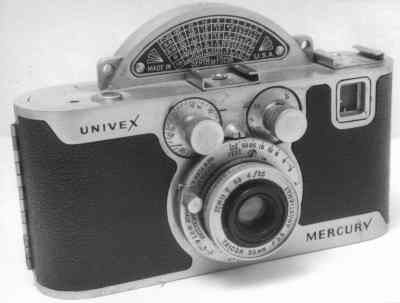
UNIVERSAL HALF FRAME CAMERAS

This was improved, "top-of-the-line" version of the original Univex Mercury. It had two major advantages over it's predecessor. First, was a top speed of 1/1,500, very unusual for the time. In addition it was typically seen with a faster lens, often a f2.0 Hexar. The lens was made by Wollensak, not Konica, but was very fast for the time.
(1946) After the war, Universal picked up production once again. But they decided to make some improvements. The fact that you could not change rolls 'in the field' was a severe drawback to the original model. The new CX model was functionally similar to the earlier Mercury, but it used regular 35mm cassettes. But the redesigned camera was half an inch taller and half an inch wider than the original -- noticeably larger. The interchangeable lens mount was the same and there were the same three lenses to choose from -- one was an f2.0, another was the original f 3.5, and the most common was the f2.7 - 22. All were 35mm. An expansion of the DOF scale was added to the back of the camera for new lenses. There were, of course, other minor changes to the camera. For example, since the new camera now used 35mm cassettes, the film counter now ran to 65 exposures. Since the film needed to be rewound into the cassette, a rewind knob was added to the top of the camera -- this is the main reason the camera is longer/wider. The front is imprinted "Mercury II" while on the back it shows "Model CX". A film release/rewind button was added to the front of the camera and a film reminder dial was added to the back. But since the post-war price was three times the pre-war price, the camera died from competition and lack of sales in a recovering economy.
COPYRIGHT @ 1995-2017 by Joe McGloin. All Rights Reserved.